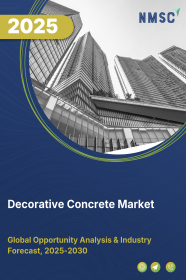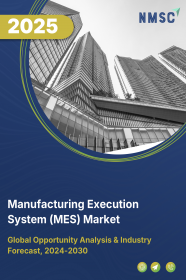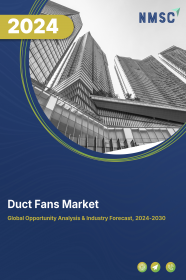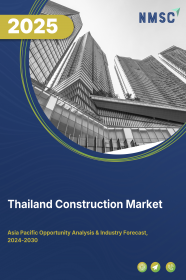
Decorative Concrete Market by Type (Stamped Concrete, Stained Concrete, Polished Concrete, Colored Concrete, Exposed Aggregate Concrete, Concrete Overlays, and Others), by Application (Floors, Driveways and Sidewalks, Walls, Pool Decks, and Others), and by End User (Residential and Non-Residential) –Global Opportunity Analysis and Industry Forecast 2025-2030
Decorative Concrete Industry Overview
The global Decorative Concrete Market size was valued at USD 18.36 billion in 2024 and is predicted to reach USD 19.37 billion by the end of 2025. The industry is predicted to reach USD 25.29 billion by 2030 with a CAGR of 5.5% from 2025-2030.
The market is primarily driven by the growing demand for aesthetic and customized surfaces, rising urbanization and infrastructure development, and the inherent versatility and durability of concrete. However, high initial costs pose a significant restraint to wider adoption. A major opportunity lies in the development of stamped concrete solutions that enhance design flexibility while reducing application complexity and overall costs.
The Growing Demand for Aesthetic and Customized Concrete Surfaces Fuels the Market Growth
One of the primary forces propelling the demand for decorative concrete in the market is the increasing consumer demand for aesthetically pleasing and customized surfaces. Homeowners, architects, and designers are increasingly seeking ways to enhance the visual appeal of their spaces, and stamped concrete offers a wide array of options to achieve this.
Techniques like stamping, staining, polishing, and texturing allow for the creation of unique looks that mimic natural stone, brick, tile, or even intricate patterns. This drive for visual appeal is evident in both residential and commercial sectors, where creating an attractive and inviting environment is crucial.
For example, a restaurant might opt for stained and polished concrete floors to create a modern and sophisticated ambiance, while a homeowner could choose stamped concrete for their patio to resemble natural stone pathways, all contributing to the market's growth potential.
The Rising Urbanization and Infrastructure Development Drive the Market Growth
The rapid pace of urbanization and significant investments in infrastructure development globally are acting as substantial drivers for the decorative concrete market growth. As cities expand and new infrastructure projects are initiated, the demand for durable, versatile, and aesthetically pleasing construction materials rise.
Decorative concrete is being increasingly utilized in public spaces, such as walkways, plazas, and parks, due to its combination of functionality and visual appeal. Moreover, in large-scale commercial and residential developments, stamped concrete offers a cost-effective and long-lasting solution for flooring, facades, and other surfaces. The sheer volume of construction activity driven by urbanization directly translates to a larger market size for decorative concrete.
The Versatility and Durability of Concrete Fuels the Market Growth
The inherent versatility and durability of concrete itself serve as a significant driver for its decorative applications. Concrete's strength and longevity make it a practical choice for high-traffic areas and outdoor environments. When combined with decorative techniques, it offers a compelling alternative to other flooring and surfacing materials that may lack either the aesthetic flexibility or the durability of concrete.
Whether it's a durable, polished concrete floor in a retail space or a weather-resistant stamped concrete driveway, the underlying strength of concrete provides a solid foundation for decorative enhancements. This blend of practicality and design freedom contributes significantly to the decorative concrete market share within the broader construction materials industry.
High Initial Costs Limit the Decorative Concrete Market Expansion
A key restraint in the broader adoption of decorative concrete is the higher initial cost compared to conventional concrete or basic flooring options. While the long-term durability and lower maintenance of stamped concrete offset these initial expenses, the upfront investment can be a barrier for budget-conscious projects.
The specialized materials, techniques, and skilled labor required for many stamped concrete applications contribute to this higher cost. Overcoming this perception of higher initial costs through education on the long-term value and potential cost savings is a challenge the industry needs to address to unlock further market growth.
Stamped Concrete Solutions Creates Future Market Opportunities
A major opportunity for players in the market lies in the continuous development and promotion of innovative and cost-effective stamped concrete solutions. This includes exploring new materials, application techniques, and design possibilities that reduce costs while maintaining or enhancing aesthetic appeal and durability.
For instance, advancements in staining technologies, the development of more user-friendly stamping tools, or the introduction of new concrete mixes that offer unique textures broaden the appeal and accessibility of decorative concrete.
A notable example is BASF’s launch of MasterTop 1400 SL, a high-performance, self-leveling overlay that combines durability with aesthetic flexibility, allowing for seamless polished concrete and terrazzo-like finishes at a lower cost. Embracing such innovations opens up new market segments and allows industry players to capture a larger market share by offering compelling alternatives to traditional materials and overcoming the cost barrier.
Market Segmentation and Scope of the Study
The decorative concrete market report is segmented by type, application, and end user. By type, the market includes stamped concrete, stained concrete, polished concrete, colored concrete, exposed aggregate concrete, concrete overlays, and others. By application, it comprises floors, driveways and sidewalks, walls, pool decks, and others. By end user, the market is segmented into residential and non-residential sectors. Regional breakdown and analysis of each of the aforesaid segments include regions comprising North America, Europe, Asia-Pacific, and RoW.
Geographical Analysis
North America posesses a well-established market with a strong emphasis on customization and aesthetic appeal in both residential and commercial sectors. The Associated General Contractors of America (AGC) reports that construction spending in the U.S. reached USD 2.1 trillion in 2023, with significant investments in residential and non-residential projects driving demand for innovative materials like decorative concrete.
The presence of organizations like the American Society of Concrete Contractors (ASCC) and events like the Decorative Concrete Experience at World of Concrete further indicate a mature and active market, where contractors and designers prioritize unique, high-quality finishes to meet consumer preferences for personalized space.
Europe also represents a significant market, with a growing interest in sustainable and aesthetically pleasing concrete solutions, driven by architectural trends and renovation activities. The focus on unique designs and the use of decorative cement to create personalized spaces is evident, particularly in urban areas undergoing revitalization.
According to the World Resources Institute, 68% of the world’s population is projected to live in urban areas by 2050, increasing the need for durable and visually appealing infrastructure in European cities. This urbanization trend supports the adoption of stamped concrete for sustainable urban development, as it aligns with the region’s emphasis on eco-friendly construction practices and aesthetic urban planning.
The Asia-Pacific region is experiencing rapid growth in the market, fueled by increasing urbanization and substantial investments in infrastructure development. The World Resources Institute highlights that India alone is expected to add 416 million urban dwellers by 2050, driving demand for robust infrastructure solutions. This rapid urbanization, coupled with India’s status as the fifth largest economy, underscores the need for durable and visually appealing surfaces in public spaces, commercial complexes, and large-scale projects.
The demand for stamped concrete in the Asia-Pacific is further amplified by government-led infrastructure initiatives, presenting significant growth potential for cost-effective and aesthetically versatile materials.
The Rest of the World encompasses emerging markets where the adoption of stamped concrete is gradually increasing, mirroring the trends seen in more developed regions but with potentially different paces of adoption and market penetration. While these regions are less prominent in the stamped concrete sector, the overarching trend of seeking durable and aesthetically enhanced concrete solutions is likely to contribute to future market growth.
Strategic Innovations Adopted by Key Players
Key players in the global decorative concrete industry are actively employing various strategies and adapting to recent developments to maintain and expand their market share in this growing sector. A significant focus is on innovation, with companies investing in research and development to introduce new products and techniques, such as glow-in-the-dark concrete and digital printing on concrete, as highlighted in recent reports.
For example, Topciment emphasizes the art of creating unique spaces with their decorative cement, showcasing their commitment to innovative aesthetic solutions. Sustainability is another key area, with manufacturers developing and promoting eco-friendly concrete solutions to meet increasing environmental concerns.
Customization remains a crucial strategy, as the demand for unique and visually appealing surfaces drives the need for diverse textures, colors, and patterns achieved through techniques like stamping and staining. Companies are also focusing on providing training and education to applicators to ensure high-quality installations, addressing the challenge of requiring skilled labor.
Events like the decorative concrete experience at World of Concrete serve as platforms for key players to showcase their latest innovations and network. However, these players face challenges such as the higher initial costs associated with stamped concrete compared to conventional options.
Opportunities lie in leveraging the increasing urbanization and infrastructure development, particularly in regions like Asia-Pacific, where the demand for aesthetically pleasing and durable surfaces is rising, representing significant growth potential. Moreover, expanding into emerging economies and developing more cost-effective solutions are key opportunities for future industry growth.
Key Benefits
-
The report provides quantitative analysis and estimations of the market from 2025 to 2030, which assists in identifying the prevailing market opportunities.
-
The study comprises a deep dive analysis of the current and future decorative concrete market trends to depict prevalent investment pockets in the market.
-
Information related to key drivers, restraints, and opportunities and their impact on the decorative concrete sector is provided in the report.
-
Competitive analysis of the players, along with their market share is provided in the report.
-
SWOT analysis and Porters Five Forces model is elaborated in the study.
-
Value chain analysis in the market study provides a clear picture of roles of stakeholders.
Decorative Concrete Market Key Segments
By Type
-
Stamped concrete
-
Stained concrete
-
Polished concrete
-
Colored concrete
-
Exposed aggregate concrete
-
Concrete overlays
-
Others
By Application
-
Floors
-
Driveways and sidewalks
-
Walls
-
Pool decks
-
Others
By End User
-
Residential
-
Non-residential
By Region
-
North America
-
The U.S.
-
Canada
-
Mexico
-
-
Europe
-
The UK
-
Germany
-
France
-
Italy
-
Spain
-
Denmark
-
Netherlands
-
Finland
-
Sweden
-
Norway
-
Russia
-
Rest of Europe
-
-
Asia Pacific
-
China
-
Japan
-
India
-
South Korea
-
Australia
-
Indonesia
-
Singapore
-
Taiwan
-
Thailand
-
Rest of Asia Pacific
-
-
RoW
-
Latin America
-
Middle East
-
Africa
-
Key Players
-
Sika Corporation
-
Heidelberg Materials Australia Group Pty Ltd
-
Holcim
-
Boral Limited
-
BASF SE
-
Mcknight Custom Concrete, Inc.
-
Deco-Crete, LLC
-
Seacoast Concrete
-
RPM International
-
Mapei SPA
-
Titan LLC
-
Eagle Materials Inc
-
Cemex S.A.B. de C.V.
-
Adbri Concrete
-
Hexion Inc.
REPORT SCOPE AND SEGMENTATION:
|
Parameters |
Details |
|
Market Size in 2024 |
USD 18.36 billion |
|
Revenue Forecast in 2030 |
USD 25.29 billion |
|
Growth Rate |
CAGR of 5.5% from 2025 to 2030 |
|
Analysis Period |
2024–2030 |
|
Base Year Considered |
2024 |
|
Forecast Period |
2025–2030 |
|
Market Size Estimation |
Billion (USD) |
|
Growth Factors |
|
|
Countries Covered |
28 |
|
Companies Profiled |
15 |
|
Market Share |
Available for 10 companies |
|
Customization Scope |
Free customization (equivalent up to 80 working hours of analysts) after purchase. Addition or alteration to country, regional, and segment scope. |
|
Pricing and Purchase Options |
Avail customized purchase options to meet your exact research needs. |

















 Speak to Our Analyst
Speak to Our Analyst





















